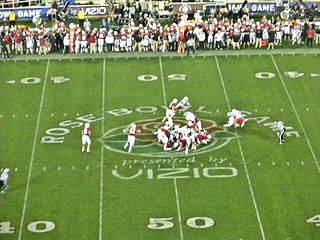
The Big Ten Conference is the oldest Division I collegiate athletic conference in the United States. Founded as the Intercollegiate Conference of Faculty Representatives in 1896, it predates the founding of its regulating organization, the NCAA. It is based in the Chicago area in Rosemont, Illinois. For many decades the conference consisted of 10 prominent universities. As of 2014, it consists of 14 member institutions and 2 affiliate institutions, with 4 new member institutions scheduled to join in 2024. The conference competes in the NCAA Division I and its football teams compete in the Football Bowl Subdivision (FBS), formerly known as Division I-A, the highest level of NCAA competition in that sport.

The Midwest Intercollegiate Volleyball Association (MIVA) is a collegiate club men's volleyball sports league in the Midwest United States. It is differentiated from the varsity Midwestern Intercollegiate Volleyball Association.
The 1985 NCAA Division I-A football season saw the Oklahoma Sooners, led by head coach Barry Switzer, win the national championship.
The 1984 NCAA Division I-A football season was topsy-turvy from start to finish. It ended with the BYU Cougars being bestowed their first and only national championship by beating Michigan in the Holiday Bowl. While the Cougars finished with a perfect 13–0 record and were the consensus National Champions, some commentators maintain this title was undeserved citing their weak schedule and argue that the championship should have gone to the 11–1 Washington Huskies. Despite this the Cougars were voted No. 1 in the final AP and UPI polls. The Huskies declined an invitation to play BYU in the Holiday Bowl; they decided instead to play Oklahoma in the more prestigious 1985 Orange Bowl. All subsequent national champions have come from what are now known as the Power Five conferences + Notre Dame.
Coaches and media of the Big Ten Conference award the following individual honors at the end of each football season. In addition, the Chicago Tribune awards the Chicago Tribune Silver Football to the most valuable football player of the conference.
The ankle knee step is a type of high step used by marching bands. It is named such because when executed properly, the ankle of one leg should be at the height of the knee of the other leg. This step is chiefly used by marching bands which consider themselves traditional or show style bands, although drum corps and corps-style marching bands may use this step sparingly for effect.
The 1933 college football season saw the Michigan Wolverines repeat as winners of the Knute Rockne Memorial Trophy as national champion under the Dickinson System.

The 2008 Big Ten Conference football season is the 113th season for the Big Ten.
The 1949 college football season finished with four teams that were unbeaten and untied-- Notre Dame, Oklahoma, California, and Army had won all their games at season's end. Notre Dame, however, was the overwhelming choice for national champion in the AP Poll, with 172 of 208 first place votes. The Fighting Irish did not participate in the New Year's Day bowl games, which were played on January 2, 1950.
The Association of Public and Land-grant Universities (APLU) is a research, policy, and advocacy organization of public research universities, land-grant institutions, state university systems, and higher education organizations. It has member campuses in all of the United States as well as the District of Columbia, four U.S. territories, Canada, and Mexico.
The 1922 NCAA Track and Field Championships was the second NCAA track and field championship. The event was held at Stagg Field in Chicago, Illinois in June 1922. The University of California won the team title, and nine NCAA records were set at the two-day meet.

The 2012 Big Ten Conference football season was the 117th season for the Big Ten. The conference began its season on September 1, as each of the conference's teams began their respective 2012 season of NCAA Division I Football Bowl Subdivision competition. This was the league's second season with a divisional format and a championship game.
The 1947 Big Nine Conference football season was the 52nd season of college football played by the member schools of the Big Nine Conference and was a part of the 1947 college football season.
The 1939 Big Ten Conference football season was the 44th season of college football played by the member schools of the Big Ten Conference and was a part of the 1939 college football season.
The 1956 Big Ten Conference football season was the 61st season of college football played by the member schools of the Big Ten Conference and was a part of the 1956 NCAA University Division football season.
The 1974 Big Ten Conference football season was the 79th season of college football played by the member schools of the Big Ten Conference and was a part of the 1974 NCAA Division I football season.
The 1976 Big Ten Conference football season was the 81st season of college football played by the member schools of the Big Ten Conference and was a part of the 1976 NCAA Division I football season.
The 1977 Big Ten Conference football season was the 82nd season of college football played by the member schools of the Big Ten Conference and was a part of the 1977 NCAA Division I football season.
The 1984 Big Ten Conference football season was the 89th season of college football played by the member schools of the Big Ten Conference and was a part of the 1984 NCAA Division I-A football season.
The drum major backbend is an elaborate salute performed by drum majors in many American university marching bands. It is executed prior to college football games as one of the rituals engaging the audience's consent for the athletic contest that follows. It is distinct from the gymnastics maneuver of the same name.




